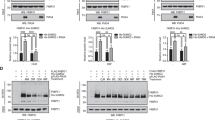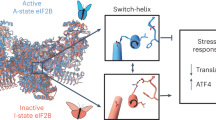Abstract
The FK506-binding protein 51 (FKBP51, encoded by the FKBP5 gene) is an established risk factor for stress-related psychiatric disorders such as major depression. Drug discovery for FKBP51 has been hampered by the inability to pharmacologically differentiate against the structurally similar but functional opposing homolog FKBP52, and all known FKBP ligands are unselective. Here, we report the discovery of the potent and highly selective inhibitors of FKBP51, SAFit1 and SAFit2. This new class of ligands achieves selectivity for FKBP51 by an induced-fit mechanism that is much less favorable for FKBP52. By using these ligands, we demonstrate that selective inhibition of FKBP51 enhances neurite elongation in neuronal cultures and improves neuroendocrine feedback and stress-coping behavior in mice. Our findings provide the structural and functional basis for the development of mechanistically new antidepressants.
This is a preview of subscription content, access via your institution
Access options
Subscribe to this journal
Receive 12 print issues and online access
$259.00 per year
only $21.58 per issue
Buy this article
- Purchase on Springer Link
- Instant access to full article PDF
Prices may be subject to local taxes which are calculated during checkout




Similar content being viewed by others
References
Cioffi, D.L., Hubler, T.R. & Scammell, J.G. Organization and function of the FKBP52 and FKBP51 genes. Curr. Opin. Pharmacol. 11, 308–313 (2011).
Sanchez, E.R. Chaperoning steroidal physiology: lessons from mouse genetic models of Hsp90 and its cochaperones. Biochim. Biophys. Acta 1823, 722–729 (2012).
Schmidt, M.V., Paez-Pereda, M., Holsboer, F. & Hausch, F. The prospect of FKBP51 as a drug target. ChemMedChem 7, 1351–1359 (2012).
Storer, C.L., Dickey, C.A., Galigniana, M.D., Rein, T. & Cox, M.B. FKBP51 and FKBP52 in signaling and disease. Trends Endocrinol. Metab. 22, 481–490 (2011).
Gaali, S., Gopalakrishnan, R., Wang, Y., Kozany, C. & Hausch, F. The chemical biology of immunophilin ligands. Curr. Med. Chem. 18, 5355–5379 (2011).
Cheung-Flynn, J. et al. Physiological role for the cochaperone FKBP52 in androgen receptor signaling. Mol. Endocrinol. 19, 1654–1666 (2005).
Tranguch, S. et al. Cochaperone immunophilin FKBP52 is critical to uterine receptivity for embryo implantation. Proc. Natl. Acad. Sci. USA 102, 14326–14331 (2005).
Yang, Z. et al. FK506-binding protein 52 is essential to uterine reproductive physiology controlled by the progesterone receptor A isoform. Mol. Endocrinol. 20, 2682–2694 (2006).
Yong, W. et al. Essential role for co-chaperone Fkbp52 but not Fkbp51 in androgen receptor–mediated signaling and physiology. J. Biol. Chem. 282, 5026–5036 (2007).
Attwood, B.K. et al. Neuropsin cleaves EphB2 in the amygdala to control anxiety. Nature 473, 372–375 (2011).
Hartmann, J. et al. The involvement of FK506-binding protein 51 (FKBP5) in the behavioral and neuroendocrine effects of chronic social defeat stress. Neuropharmacology 62, 332–339 (2012).
O'Leary, J.C. III et al. A new anti-depressive strategy for the elderly: ablation of FKBP5/FKBP51. PLoS ONE 6, e24840 (2011).
Touma, C. et al. FK506 binding protein 5 shapes stress responsiveness: modulation of neuroendocrine reactivity and coping behavior. Biol. Psychiatry 70, 928–936 (2011).
Albu, S. et al. Deficiency of FK506-binding protein (FKBP) 51 alters sleep architecture and recovery sleep responses to stress in mice. J. Sleep Res. 23, 176–185 (2014).
Zannas, A.S. & Binder, E.B. Gene-environment interactions at the FKBP5 locus: sensitive periods, mechanisms and pleiotropism. Genes Brain Behav. 13, 25–37 (2014).
Zou, Y.-F. et al. Meta-analysis of FKBP5 gene polymorphisms association with treatment response in patients with mood disorders. Neurosci. Lett. 484, 56–61 (2010).
Blackburn, E.A. & Walkinshaw, M.D. Targeting FKBP isoforms with small-molecule ligands. Curr. Opin. Pharmacol. 11, 365–371 (2011).
Fabian, A.-K. et al. InterAKTions with FKBPs—mutational and Pharmacological Exploration. PLoS ONE 8, e57508 (2013).
Hausch, F., Kozany, C., Theodoropoulou, M. & Fabian, A.-K. FKBPs and the Akt/mTOR pathway. Cell Cycle 12, 2366–2370 (2013).
Bracher, A. et al. Crystal structures of the free and ligand-bound FK1–FK2 domain segment of FKBP52 reveal a flexible inter-domain hinge. J. Mol. Biol. 425, 4134–4144 (2013).
Bracher, A., Kozany, C., Thost, A.K. & Hausch, F. Structural characterization of the PPIase domain of FKBP51, a cochaperone of human Hsp90. Acta Crystallogr. D Biol. Crystallogr. 67, 549–559 (2011).
März, A.M., Fabian, A.-K., Kozany, C., Bracher, A. & Hausch, F. Large FK506-binding proteins shape the pharmacology of rapamycin. Mol. Cell. Biol. 33, 1357–1367 (2013).
Clackson, T. et al. Redesigning an FKBP-ligand interface to generate chemical dimerizers with novel specificity. Proc. Natl. Acad. Sci. USA 95, 10437–10442 (1998).
Banaszynski, L.A., Chen, L.-C., Maynard-Smith, L.A., Ooi, A.G.L. & Wandless, T.J.A. Rapid, reversible, and tunable method to regulate protein function in living cells using synthetic small molecules. Cell 126, 995–1004 (2006).
Quintá, H.R., Maschi, D., Gomez-Sanchez, C., Piwien-Pilipuk, G. & Galigniana, M.D. Subcellular rearrangement of hsp90-binding immunophilins accompanies neuronal differentiation and neurite outgrowth. J. Neurochem. 115, 716–734 (2010).
Evans, D.A., Ennis, M.D., Le, T., Mandel, N. & Mandel, G. Asymmetric acylation reactions of chiral imide enolates. The first direct approach to the construction of chiral β-dicarbonyl synthons. J. Am. Chem. Soc. 106, 1154–1156 (1984).
Myers, A.G. et al. Pseudoephedrine as a practical chiral auxiliary for the synthesis of highly enantiomerically enriched carboxylic acids, alcohols, aldehydes, and ketones. J. Am. Chem. Soc. 119, 6496–6511 (1997).
Gopalakrishnan, R. et al. Evaluation of synthetic FK506 analogues as ligands for the FK506-binding proteins 51 and 52. J. Med. Chem. 55, 4114–4122 (2012).
Gopalakrishnan, R. et al. Exploration of pipecolate sulfonamides as binders of the FK506-binding proteins 51 and 52. J. Med. Chem. 55, 4123–4131 (2012).
Wang, Y. et al. Increasing the efficiency of ligands for FK506-binding protein 51 by conformational control. J. Med. Chem. 56, 3922–3935 (2013).
Weiwad, M. et al. Comparative analysis of calcineurin inhibition by complexes of immunosuppressive drugs with human FK506 binding proteins. Biochemistry 45, 15776–15784 (2006).
Price, R.D. et al. FK1706, a novel non-immunosuppressive immunophilin: neurotrophic activity and mechanism of action. Eur. J. Pharmacol. 509, 11–19 (2005).
Revill, W.P. et al. Genetically engineered analogs of ascomycin for nerve regeneration. J. Pharmacol. Exp. Ther. 302, 1278–1285 (2002).
Babine, R.E., Villafranca, J.E. & Gold, B.G. FKBP immunophilin patents for neurological disorders. Expert. Opin. Ther. Patents 15, 555–573 (2005).
Gerard, M., Deleersnijder, A., Demeulemeester, J., Debyser, Z. & Baekelandt, V. Unraveling the role of peptidyl-prolyl isomerases in neurodegeneration. Mol. Neurobiol. 44, 13–27 (2011).
Gold, B.G., Densmore, V., Shou, W., Matzuk, M.M. & Gordon, H.S. Immunophilin FK506-binding protein 52 (not FK506-binding protein 12) mediates the neurotrophic action of FK506. J. Pharmacol. Exp. Ther. 289, 1202–1210 (1999).
Sugimoto, Y. et al. Differences between mice strains in response to paroxetine in the forced swimming test: involvement of serotonergic or noradrenergic systems. Eur. J. Pharmacol. 672, 121–125 (2011).
Touma, C. Stress and affective disorders: animal models elucidating the molecular basis of neuroendocrine-behavior interactions. Pharmacopsychiatry 44 (suppl. 1), S15–S26 (2011).
Hartmann, J. et al. Fkbp52 heterozygosity alters behavioral, endocrine and neurogenetic parameters under basal and chronic stress conditions in mice. Psychoneuroendocrinology 37, 2009–2021 (2012).
Raison, C.L. & Miller, A.H. When not enough is too much: the role of insufficient glucocorticoid signaling in the pathophysiology of stress-related disorders. Am. J. Psychiatry 160, 1554–1565 (2003).
Ising, M. et al. Combined dexamethasone/corticotropin releasing hormone test predicts treatment response in major depression-a potential biomarker? Biol. Psychiatry 62, 47–54 (2007).
Klengel, T. et al. Allele-specific FKBP5 DNA demethylation mediates gene-childhood trauma interactions. Nat. Neurosci. 16, 33–41 (2013).
Kozany, C., März, A., Kress, C. & Hausch, F. Fluorescent probes to characterise FK506-binding proteins. ChemBioChem 10, 1402–1410 (2009).
Brittain, D.E. et al. Total synthesis of antascomicin B. Angew. Chem. Int. Edn. Engl. 44, 2732–2737 (2005).
Kabsch, W. XDS. Acta Crystallogr. D Biol. Crystallogr. 66, 125–132 (2010).
Evans, P. Scala. Joint CCP4 and ESF-EACBM Newsletter 33, 22–24 (1997).
French, G.S. & Wilson, K.S. On the treatment of negative intensity observations. Acta Crystallogr. A 34, 517–525 (1978).
Collaborative Computational Project N. The CCP4 suite: programs for protein crystallography. Acta Crystallogr. D Biol. Crystallogr 50, 760–763 (1994).
Vagin, A.A. & Isupov, M.N. Spherically averaged phased translation function and its application to the search for molecules and fragments in electron-density maps. Acta Crystallogr. D Biol. Crystallogr. 57, 1451–1456 (2001).
Emsley, P. & Cowtan, K. Coot: model-building tools for molecular graphics. Acta Crystallogr. D Biol. Crystallogr. 60, 2126–2132 (2004).
Murshudov, G.N., Vagin, A.A. & Dodson, E.J. Refinement of macromolecular structures by the maximum-likelihood method. Acta Crystallogr. D Biol. Crystallogr. 53, 240–255 (1997).
Schüttelkopf, A.W. & van Aalten, D.M.F. PRODRG—a tool for high-throughput crystallography of protein-ligand complexes. Acta Crystallogr. D Biol. Crystallogr. 60, 1355–1363 (2004).
Delano, W.L. The Pymol Molecular Graphics System (DeLano Scientific, 2002).
Draenert, R. et al. Comparison of overlapping peptide sets for detection of antiviral CD8 and CD4 T cell responses. J. Immunol. Methods 275, 19–29 (2003).
Beurel, E., Harrington, L.E. & Jope, R.S. Inflammatory T helper 17 cells promote depression-like behavior in mice. Biol. Psychiatr. 73, 622–630 (2013).
Zhang, Y., Huo, M., Zhou, J. & Xie, S. PKSolver: An add-in program for pharmacokinetic and pharmacodynamic data analysis in Microsoft Excel. Comput. Methods Programs Biomed. 99, 306–314 (2010).
Touma, C. et al. Mice selected for high versus low stress reactivity: a new animal model for affective disorders. Psychoneuroendocrinology 33, 839–862 (2008).
Acknowledgements
This work was supported by the M4 Award 2011 from the Bayrisches Staatsministerium für Wirtschaft, Infrastruktur Verkehr und Technologie (to F.H.). We thank A. Vogel, S. Giusti, D. Refojo (Max Planck Institute of Psychiatry) and M. Baumann (Lead Discovery Center) for experimental advice and L. Tietze, T. Gerlach and B. Hoogeland for technical support. We are indebted to E. Weyher (Max Planck Institute of Biochemistry) and to C. Dubler (Ludwig-Maximilians-University Munich) for high-resolution MS and NMR measurements. We thank S. Ley for a sample of antascomycin B (University of Cambridge, UK); the Joint Structural Biology Group staff at the European Synchrotron Radiation Facility in Grenoble, France; the staff at beamline X10SA of the Swiss Synchrotron Light Source (SLS) in Villigen, Switzerland; and F. Holsboer for continuous support.
Author information
Authors and Affiliations
Contributions
F.H. conceived the project; S.G. designed and synthesized FKBP ligands; G.R. contributed to the design of ligand 1, iFit 4 and SAFit2; A.K. and S.C. performed neurite outgrowth experiments; C.K. and C.S. performed FKBP binding assays; P.F.-V. and O.X.F.A. supported primary neuron experiments; C.N. and M.U. measured PK parameters; A.B. performed crystallographic analyses; J.H., G.B., M.V.S. and C.T. performed animal behavioral testing. A.S.Z., R.D. and E.B.B. designed and performed the immune experiments. S.G., A.K., P.F.-V., O.X.F.A., A.B. and F.H. wrote the manuscript.
Corresponding author
Ethics declarations
Competing interests
Declaration: A.K., S.G., G.R., A.B. and F.H. have filed a patent application for selective FKBP51 inhibitors (EP 13185247). E.B. is co-inventor on European Patent no. EP 1687443 B1, 'FKBP5: a novel target for antidepressant therapy'.
Supplementary information
Supplementary Text and Figures
Supplementary Results, Supplementary Tables 1 and 2, Supplementary Figures 1–14 and Supplementary Note. (PDF 2659 kb)
Rights and permissions
About this article
Cite this article
Gaali, S., Kirschner, A., Cuboni, S. et al. Selective inhibitors of the FK506-binding protein 51 by induced fit. Nat Chem Biol 11, 33–37 (2015). https://doi.org/10.1038/nchembio.1699
Received:
Accepted:
Published:
Issue Date:
DOI: https://doi.org/10.1038/nchembio.1699
This article is cited by
-
Knocking out Fkbp51 decreases CCl4-induced liver injury through enhancement of mitochondrial function and Parkin activity
Cell & Bioscience (2024)
-
FKBP12 is a major regulator of ALK2 activity in multiple myeloma cells
Cell Communication and Signaling (2023)
-
SAFit2 ameliorates paclitaxel-induced neuropathic pain by reducing spinal gliosis and elevating pro-resolving lipid mediators
Journal of Neuroinflammation (2023)
-
Large-scale, in-cell photocrosslinking at single-residue resolution reveals the molecular basis for glucocorticoid receptor regulation by immunophilins
Nature Structural & Molecular Biology (2023)
-
FKBP5 inhibitors modulate alcohol drinking and trauma-related behaviors in a model of comorbid post-traumatic stress and alcohol use disorder
Neuropsychopharmacology (2023)



